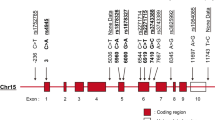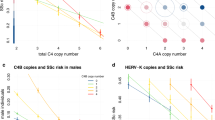Abstract
Systemic sclerosis (SSc; scleroderma) is a connective tissue disease, characterized by fibrotic, immunological, and vascular abnormalities. Interleukin-10 (IL-10) is an anti-inflammatory cytokine that modulates collagen production and B-cell survival. To determine if certain IL-10 genotypes are risk factors for the development of SSc and influence disease-associated autoimmune responses, 248 Caucasian and 264 Japanese SSc patients and controls were genotyped for three loci: −3575, −2849, and −2763. Sera from patients were characterized for SSc-associated autoantibodies. In Caucasians, at −3575 and −2763, the frequency of AA homozygotes was higher in patients as compared with controls (P=0.0005; P=0.002). In Japanese subjects, the frequency of AC heterozygotes at −2763 was higher, and that of CC homozygotes lower, in patients with diffuse SSc as compared to controls (P=0.04). Particular IL-10 genotypes were associated with SSc-related autoantibodies. These results suggest that IL-10 genotypes contribute to the etiology of scleroderma.
This is a preview of subscription content, access via your institution
Access options
Subscribe to this journal
Receive 6 digital issues and online access to articles
$119.00 per year
only $19.83 per issue
Buy this article
- Purchase on Springer Link
- Instant access to full article PDF
Prices may be subject to local taxes which are calculated during checkout
Similar content being viewed by others
References
Moore KW, de Waal Malefyt R, Coffman RL, O'Garra A . Interleukin-10 and the interleukin-10 receptor. Annu Rev Immunol 2001; 19: 683–765.
Moroguchi A, Ishimura K, Okano K, Wakabayashi H, Maeba T, Maeta H . Interleukin-10 suppresses proliferation and remodeling of extracellular matrix of cultured human skin fibroblasts. Eur Surg Res 2004; 36: 39–44.
Yamamoto T, Eckes B, Krieg T . Effect of interleukin-10 on the gene expression of type I collagen, fibronectin, and decorin in human skin fibroblasts: differential regulation by transforming growth factor-beta and monocyte chemoattractant protein-1. Biochem Biophys Res Commun 2001; 281: 200–205.
Westendorp RG, Langermans JA, Huizinga TW, Verweij CL, Sturk A . Genetic influence on cytokine production in meningococcal disease. Lancet 1997; 349: 1912–1913.
Eskdale J, Gallagher G, Verweij CL, Keijsers V, Westendorp RG, Huizinga TW . Interleukin 10 secretion in relation to human IL-10 locus haplotypes. Proc Natl Acad Sci USA 1998; 95: 9465–9470.
Gibson AW, Edberg JC, Wu J, Westendorp RG, Huizinga TW, Kimberly RP . Novel single nucleotide polymorphisms in the distal IL-10 promoter affect IL-10 production and enhance the risk of systemic lupus erythematosus. J Immunol 2001; 166: 3915–3922.
Roncarolo MG, Battaglia M, Gregori S . The role of interleukin 10 in the control of autoimmunity. J Autoimmun 2003; 20: 269–272.
LeRoy EC, Black C, Fleischmajer R et al. Scleroderma (systemic sclerosis): classification, subsets and pathogenesis. J Rheumatol 1988; 15: 202–205.
Weiner ES, Earnshaw WC, Senecal JL, Bordwell B, Johnson P, Rothfield NF . Clinical associations of anticentromere antibodies and antibodies to topoisomerase I. A study of 355 patients. Arthritis Rheum 1988; 31: 378–385.
Gilchrist FC, Bunn C, Foley PJ et al. Class II HLA associations with autoantibodies in scleroderma: a highly significant role for HLA-DP. Genes Immun 2001; 2: 76–81.
Tan EM, Chan EK, Sullivan KF, Rubin RL . Antinuclear antibodies (ANAs): diagnostically specific immune markers and clues toward the understanding of systemic autoimmunity. Clin Immunol Immunopathol 1988; 47: 121–141.
Kuwana M, Kaburaki J, Okano Y, Tojo T, Homma M . Clinical and prognostic associations based on serum antinuclear antibodies in Japanese patients with systemic sclerosis. Arthritis Rheum 1994; 37: 75–83.
Tan FK, Wang N, Kuwana M et al. Association of fibrillin 1 single-nucleotide polymorphism haplotypes with systemic sclerosis in Choctaw and Japanese populations. Arthritis Rheum 2001; 44: 893–901.
Arnett FC . HLA and autoimmunity in scleroderma (systemic sclerosis). Int Rev Immunol 1995; 12: 107–128.
Kameda H, Pandey JP, Kaburaki J, Inoko H, Kuwana M . Immunoglobulin allotype gene polymorphisms in systemic sclerosis: interactive effect of MHC class II and KM genes on anticentromere antibody production. Ann Rheum Dis 1998; 57: 366–370.
Masi AT . Classification of systemic sclerosis (scleroderma): relationship of cutaneous subgroups in early disease to outcome and serologic reactivity. J Rheumatol 1988; 15: 894–898.
Moraes MO, Santos AR, Schonkeren JJ et al. Interleukin-10 promoter haplotypes are differently distributed in the Brazilian versus the Dutch population. Immunogenetics 2003; 54: 896–899.
Crilly A, Hamilton J, Clark CJ, Jardine A, Madhok R . Analysis of the 5′ flanking region of the interleukin 10 gene in patients with systemic sclerosis. Rheumatology (Oxford) 2003; 42: 1295–1298.
Sato H, Lagan AL, Alexopoulou C et al. The TNF-863A allele strongly associates with anticentromere antibody positivity in scleroderma. Arthritis Rheum 2004; 50: 558–564.
Wandstrat A, Wakeland E . The genetics of complex autoimmune diseases: non-MHC susceptibility genes. Nat Immunol 2001; 2: 802–809.
Goddard KA, Hopkins PJ, Hall JM, Witte JS . Linkage disequilibrium and allele-frequency distributions for 114 single-nucleotide polymorphisms in five populations. Am J Hum Genet 2000; 66: 216–234.
Acknowledgements
This work was supported in part by the US Department of Energy cooperative agreement DE-FC09-02CH11109. We are grateful to the study subjects for their blood donation and to the physicians for facilitating the patient participation.
Author information
Authors and Affiliations
Corresponding author
Rights and permissions
About this article
Cite this article
Hudson, L., Rocca, K., Kuwana, M. et al. Interleukin-10 genotypes are associated with systemic sclerosis and influence disease-associated autoimmune responses. Genes Immun 6, 274–278 (2005). https://doi.org/10.1038/sj.gene.6364180
Received:
Revised:
Accepted:
Published:
Issue Date:
DOI: https://doi.org/10.1038/sj.gene.6364180
Keywords
This article is cited by
-
Association of the interleukin-10 1082G/A, 819C/T and 3575T/A gene polymorphisms with systemic sclerosis: a meta-analysis
Molecular Biology Reports (2012)
-
Association between ‘interleukin’ 10 gene (IL10) polymorphisms and systemic sclerosis with interstitial lung involvement
Rheumatology International (2008)



